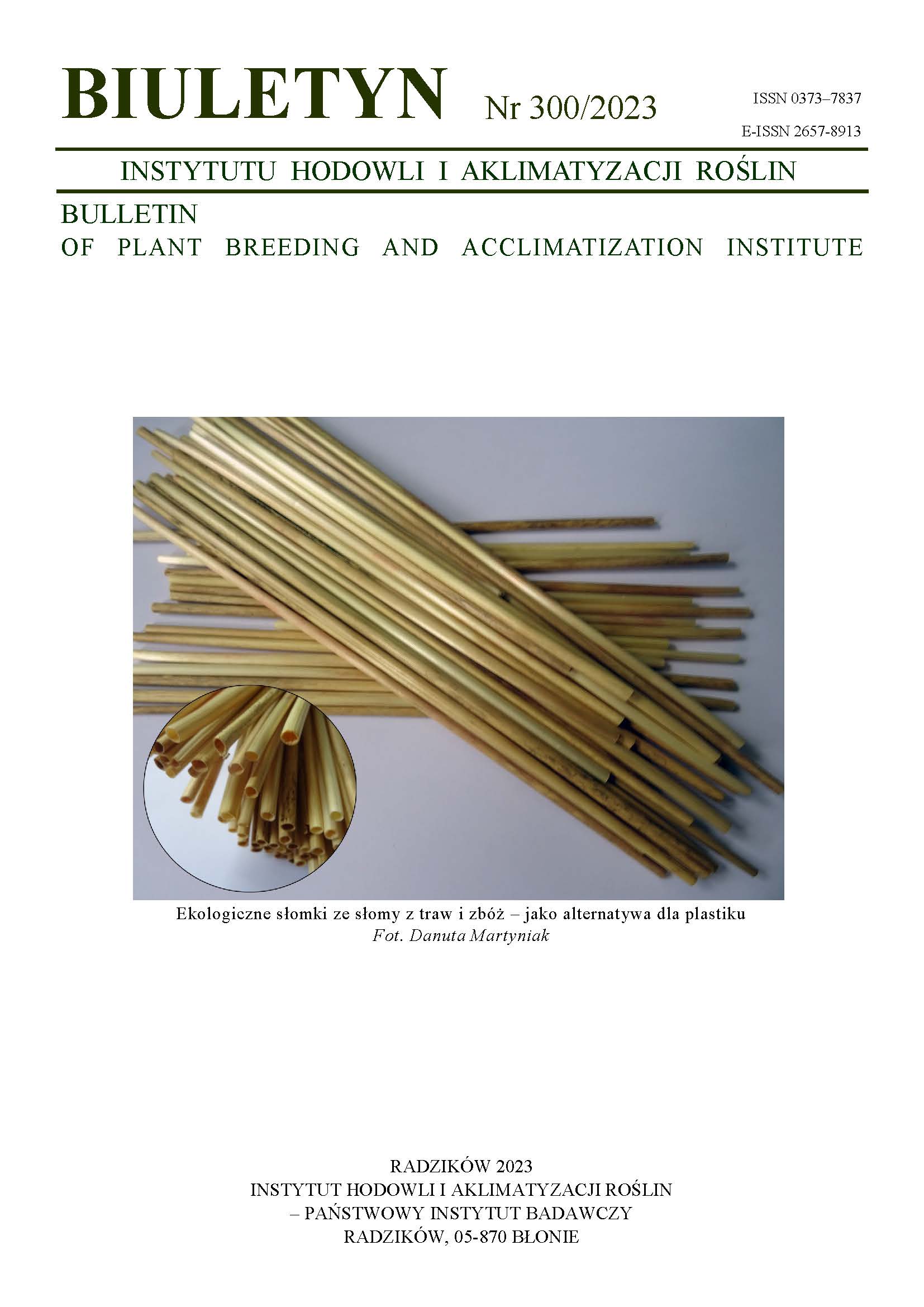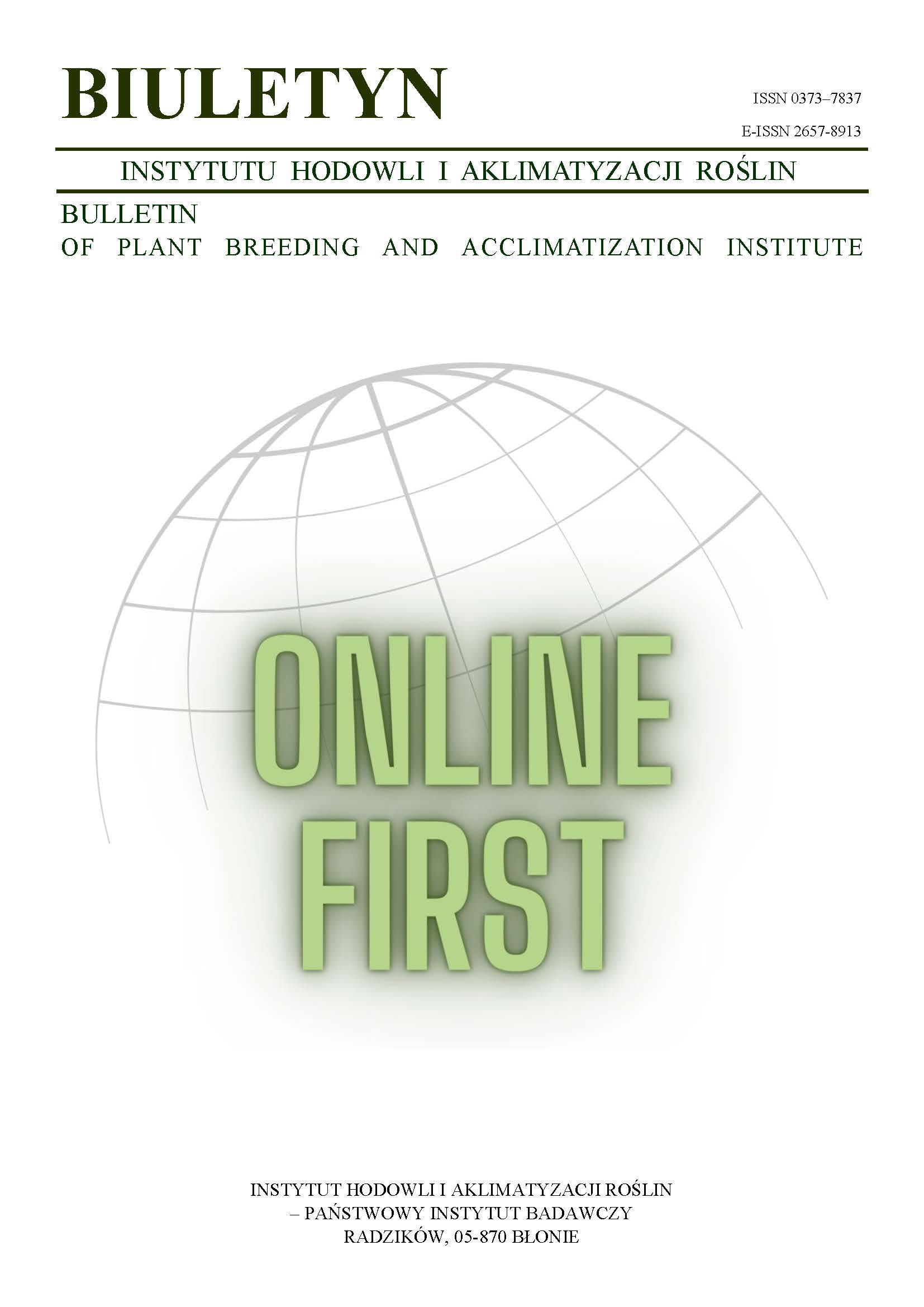Pathotypes of Synchytrium endobioticum (Schilb.) Perc. occurring in Poland
Elżbieta Malinowska
e.malinowska@ihar.edu.plInstytut Hodowli i Aklimatyzacji Roślin w Radzikowie Oddział Bydgoszcz, Pracownia Chorób i Szkodników Kwarantannowych Ziemniaka (Poland)
Janina Butrymowicz
Główny Inspektorat Ochrony Roślin i Nasiennictwa, Centralne Laboratorium, Warszawa (Poland)
Abstract
In the past, potato wart disease was a serious problem in Poland. Since 1955, in order to eradicate the pathogen, potato cultivars resistant to the pathotype 1(D1) of Synchytrium endobioticum, have only been released to be grown in Poland. No new foci caused by this pathotype have been detected since the early 1960s. In 1961 and 1965, two other pathotypes of S. endobioticum were discovered. These pathotypes, named 2(Ch1) and 3(M1), were found to be specific to Poland, and to differ from other pathotypes occurring in northwest Europe. Until 1999, the virulence of over 700 isolates was tested with the use of Glynne-Lemmerzahl and Spieckermann’s methods. Since the middle of the sixties, no new pathotype has been identified in Poland. Potato cultivars: Ackersegen, Amsel, Baltyk, Blanik, Deodara, Desiree, Fortuna (old), Giewont, Irmgard, Maxilla, Nova, Sissi, Tomensa, Ultimus, Universal, and Xenia, were found to be susceptible to wart pathotypes identified in Poland. The main difference between pathotypes 2(Ch1) and 3(M1) is in the response of potato cv. Saphir, which is resistant to 2(Ch1), but susceptible to 3(M1).
Keywords:
Synchytrium endobioticum, potato wart disease, pathotypes, virulenceReferences
Biuletyn Kwarantanny i Ochrony Roślin. 1957. Ministerstwo Rolnictwa. Departament Kwarantanny i Ochrony Roślin. Warszawa, Nr 1: 10 — 22.
Google Scholar
Braun H. 1942. Biologische Spezialisierung bei Synchytrium endobioticum (Schilb.) Perc. (Vorläufige Mitteilung). Zeit. Pflanzenkrankheiten und Pflanzenschutz 52: 481 — 486.
Google Scholar
Browning I. A. 1995. A comparison of laboratory and field reactions of a range of potato cultivars to infection by Synchytrium endobioticum. Potato Research 38: 273 — 281.
Google Scholar
EPPO 1977. First report on Working Party on Potato Wart Disease. EPPO Publications, Series C, No. 50, EPPO, Paris.
Google Scholar
EPPO 2004. EPPO Standards PM 7/28(1) Diagnostic protocol for Synchytrium endobioticum. Bulletin OEPP/EPPO Bulletin 34, 213 — 218.
Google Scholar
EU 1969. Council Directive 69/464 on control of potato wart disease. Official Journal of the European Communities No. L323/1: 561 — 562.
Google Scholar
Glynne M. D. 1925. Infection experiments with wart disease of potatoes Synchytrium endobioticum (Schilb.) Perc. Ann. Appl. Biol. 13: 34 — 60.
Google Scholar
Hampson M. C. 1993. History, biology and control of potato wart disease in Canada. Can. J. Plant Pathol. 15: 223 — 244.
Google Scholar
Hehl R., Faurie E., Hesselbach J., Salamini F., Whitham S., Baker B., Gebhardt C. 1999. TMV resistance gene N homologues are linked to Synchytrium endobioticum resistance in potato. Theor. Appl. Genet. 98: 379 — 386.
Google Scholar
Hendriks H., Pieters R. 1998. Wart disease in the Netherlands. Annual Report 1997 of the Diagnostic Centre, Plant Protection Service, Wageningen, the Netherlands. Verslagen en Mededelingen van de Plantenziektenkundige Dienst 193: 88 — 91.
Google Scholar
Hey A. 1959. Die Kartoffelkrebsforschung in der Deutschen Demokratischen Republik und ihre praktische Auswertung. Sbornik CSAZV Rostlinna Vyroba, 6: 59 — 68.
Google Scholar
Hille M. 1965. Die Beurteilung von Kartoffelsorten hinsichtlich ihres Verhaltens gegenüber Synchytrium endobioticum (Schilb.) Perc., dem Erreger des Kartoffelkrebses. Nachrichtenblatt des Deutschen Pflanzenschutzdienstes 17: 137 — 142.
Google Scholar
Lemmerzahl J. 1930. Beiträge zur Bekämpfung des Kartoffelkrebses. Phytopathol. Z. 2: 257 — 320.
Google Scholar
Langerfeld E., Stachewicz H. 1994. Assessment of varietal reactions to potato wart (Synchytrium endobioticum) in Germany. EPPO Bulletin 24: 793 — 798.
Google Scholar
Langerfeld E., Stachewicz H., Rintelen J. 1994. Pathotypes of Synchytrium endobioticum in Germany. EPPO Bulletin 24: 799 — 804.
Google Scholar
Malec K. 1974. Z badań nad powstawaniem nowych, bardziej wirulentnych biotypów grzyba Synchytrium endobioticum (Schilb.) Perc. Biul. Inst. Ziemn. 14: 131 — 136.
Google Scholar
Malec K. 1980. Metodyka badań rakoodporności materiałów hodowlanych ziemniaka, stosowana w Samodzielnej Pracowni Badania Odporności na Choroby i Szkodniki Kwarantannowe Ziemniaka. Biul. Inst. Ziemn. 25: 125 — 139.
Google Scholar
Malec K. 1981. Biotypy grzyba Synchytrium endobioticum (Schilb.) Perc. w Polsce. Instytut Ziemniaka w Boninie (maszynopis): 1 — 38.
Google Scholar
Malec K. 1983. Rak ziemniaka — [Synchytrium endobioticum (Schilb.) Perc.]. Bonin 1983: 1 — 25.
Google Scholar
Melnik P.A. 1998. Wart disease of potato, Synchytrium endobioticum (Schilb.) Perc. EPPO Technical document No. 1032, Paris.
Google Scholar
Potoček J., Krajičkova K., Klabzubova S., Krejcar Z., Hnizdil M., Novak F., Perlova V. 1991. Identification of new Synchytrium endobioticum (Schilb.) Perc. pathotypes in Czech Republic. Ochr. Rostl. 27: 191 — 205.
Google Scholar
Putnam M. L., Sindermann A. B. 1994. Eradication of potato wart disease from Maryland. Am. Potato J. 71: 743 — 747.
Google Scholar
Rozporządzenie Ministra Rolnictwa i Rozwoju Wsi z dnia 5 sierpnia 2004r. w sprawie szczegółowych sposobów postępowania przy zwalczaniu i zapobieganiu rozprzestrzeniania się grzyba Synchytrium endobioticum. Dz.U. z dnia 24 sierpnia 2004.
Google Scholar
Smith I. M., McNamara D. G., Scott P. R., Holderness M., Burgess B. 1997. Quarantine pests for Europe. Second edition. Data sheets on quarantine pests for the European Union and for the EPPO. CAB International, Wallingford.
Google Scholar
Spieckermann A., Kothoff P. 1924. Die Prüfung von Kartoffeln auf Krebsfetigkeit. Dtsch. Landwirts. Press 51: 114 — 115.
Google Scholar
Stachewicz H. 1980. Identifizierung von Pathotypen des Kartoffelkrebserregers Synchytrium endobioticum (Schilb.) Perc.- mit Hilfe von Testsorten. Arch. Phytopathol. u. Pflanzenschutz.16: 1 — 11
Google Scholar
Stefan K., Malinowska E. 2000. Metodyka badania odporności materiałów hodowlanych ziemniaka na raka, mątwika ziemniaczanego i mątwika agresywnego. Ziemniak Polski. 1: 26 — 30.
Google Scholar
Ullrich J. 1959. Die physiologische Spezialisierung von Synchytrium endobioticum (Schilb.) Perc. in der Bundesrepublik. Sbornik CSAZV Rostlinna Vyroba, 6: 111 — 116.
Google Scholar
Authors
Elżbieta Malinowskae.malinowska@ihar.edu.pl
Instytut Hodowli i Aklimatyzacji Roślin w Radzikowie Oddział Bydgoszcz, Pracownia Chorób i Szkodników Kwarantannowych Ziemniaka Poland
Authors
Janina ButrymowiczGłówny Inspektorat Ochrony Roślin i Nasiennictwa, Centralne Laboratorium, Warszawa Poland
Statistics
Abstract views: 34PDF downloads: 17
License
Copyright (c) 2007 Elżbieta Malinowska, Janina Butrymowicz

This work is licensed under a Creative Commons Attribution-ShareAlike 4.0 International License.
Upon submitting the article, the Authors grant the Publisher a non-exclusive and free license to use the article for an indefinite period of time throughout the world in the following fields of use:
- Production and reproduction of copies of the article using a specific technique, including printing and digital technology.
- Placing on the market, lending or renting the original or copies of the article.
- Public performance, exhibition, display, reproduction, broadcasting and re-broadcasting, as well as making the article publicly available in such a way that everyone can access it at a place and time of their choice.
- Including the article in a collective work.
- Uploading an article in electronic form to electronic platforms or otherwise introducing an article in electronic form to the Internet or other network.
- Dissemination of the article in electronic form on the Internet or other network, in collective work as well as independently.
- Making the article available in an electronic version in such a way that everyone can access it at a place and time of their choice, in particular via the Internet.
Authors by sending a request for publication:
- They consent to the publication of the article in the journal,
- They agree to give the publication a DOI (Digital Object Identifier),
- They undertake to comply with the publishing house's code of ethics in accordance with the guidelines of the Committee on Publication Ethics (COPE), (http://ihar.edu.pl/biblioteka_i_wydawnictwa.php),
- They consent to the articles being made available in electronic form under the CC BY-SA 4.0 license, in open access,
- They agree to send article metadata to commercial and non-commercial journal indexing databases.
Similar Articles
- Marian Flis, The amount of damages caused by wild boars to cultivating crops in the field hunting area in the years 1999–2000 and 2008–2009 , Bulletin of Plant Breeding and Acclimatization Institute: No. 254 (2009): Regular issue
- Katarzyna Rymuza, Elżbieta Radzka, Tomasz Lenartowicz, Analysis of genotype-environment interaction for the yield of medium early potato cultivars , Bulletin of Plant Breeding and Acclimatization Institute: No. 281 (2017): Regular issue
- Dariusz R. Mańkowski, Zbigniew Laudański, Biological progress in breeding, seed technology and production of potato in Poland. Part IV. Assessment of cultivar quality progress in respect of resistance to pathogens , Bulletin of Plant Breeding and Acclimatization Institute: No. 254 (2009): Regular issue
- Sławomir Bartosiak, Automation of septoria disease image analysis using Python programming language. , Bulletin of Plant Breeding and Acclimatization Institute: No. 289 (2020): Regular issue
- Zbigniew Czerko, The effects of some factors upon the rate of potato tuber sprouting during storage , Bulletin of Plant Breeding and Acclimatization Institute: No. 257/258 (2010): Regular issue
- Cezary Trawczyński, Anna Wierzbicka, The cultivar and environmental difference of glycoalkaloids content in potato tubers , Bulletin of Plant Breeding and Acclimatization Institute: No. 262 (2011): Regular issue
- Krystyna Zarzyńska, Productivity of new potato cultivars under organic and conventional production system , Bulletin of Plant Breeding and Acclimatization Institute: No. 299 (2023): Regular issue
- Milena Pietraszko, Dominika Boguszewska-Mańkowska, Influence of irrigation on bacterial ring rot infection in potato progeny tubers , Bulletin of Plant Breeding and Acclimatization Institute: No. 263 (2012): Regular issue
- Leszek Domański, Dariusz R. Mańkowski, Bogdan Flis, Henryka Jakuczun, Ewa Zimnoch-Guzowska, Multivariate analysis of phenotypic diversity in the tetraploid × diploid hybrid progenies of potatoes , Bulletin of Plant Breeding and Acclimatization Institute: No. 264 (2012): Regular issue
- Milena Pietraszko, Dominika Boguszewska-Mańkowska, Wojciech Nowacki, Development of potato ring rot in tubers of cultivar Drop during storage period , Bulletin of Plant Breeding and Acclimatization Institute: No. 269 (2013): Regular issue
<< < 7 8 9 10 11 12 13 14 15 16 17 18 19 20 21 > >>
You may also start an advanced similarity search for this article.













